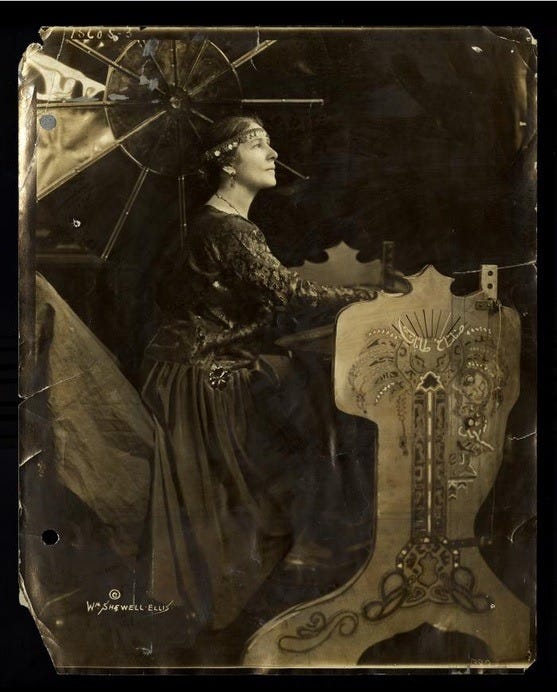from the archive
Sometimes, while wandering the archive, you encounter luminous figures you’ve never heard of, but whose work surprises and shocks you, and you don’t know how you didn’t know about them before. Mary Hallock-Greenewalt is one such person: a musician, artist, and inventor whose life’s mission was to explore the relationship between sound and light. The work she left behind reflects her innovative and ambitious spirit, and also, her inclination towards dreaming. Born in 1871, in Beirut, Hallock-Greenewalt moved to Philadelphia at age eleven. She was classically trained as a pianist in Philadelphia and Vienna, which undoubtedly impacted her interest in music’s possibilities beyond sound. She was a master of the piano, which allowed her to be an innovator of its sound, giving her the ability to manipulate it and transform it into something new.
During her lifetime, Hallock-Greenewalt witnessed groundbreaking developments in photography and cinema. I’m so drawn to this time period, or perhaps a little jealous or nostalgic for what it would have been like to see camera technologies develop so drastically over a lifetime. Who wouldn’t want to try their hand at inventing something in that kind of environment? Hallock-Greenewalt did just that—she pioneered her own instruments that would combine visual and sonic art forms.
Hallock-Greenewalt developed a light-sound instrument which she named after her mother, Sara Tabet, shortened to Sarabet. The instrument was transported and played at various locations. Of the instrument, Hallock-Greenewalt wrote,
“A new kind of artist is seated at the instrument. An artist who plays light exclusively. If there is sound or dancing or poetry or blank verse or even pictures produced simultaneously it must be handled by other means or other people. Two hands, two feet are needed for either one or the other though conceivable the automatically produced could enter in.”
Not only did she invent the Sarabet, but she was also one of the first artists to name and practice the art of turning sound to light, an art form she deemed “Norathur,” a portmanteau of the Arabic words for light and essence. Apart from the aesthetic benefits of this art, Hallock-Greenewalt also asserted that the Sarabet could even have health benefits on its players and spectators. As Anne Ciecko, writes in her analysis of Hallock-Greenewalt’s autobiography, “a color organ was installed in the Delaware State Hospital, and another was commissioned and installed in 1926 at Longwood Gardens, the multi-acre public horticultural venue founded by Pierre du Pont.”1
Though they’re lost, Hallock-Greenewalt also worked with cinema, making hand-painted films akin to those made by Len Lye.
There are undoubtedly many layers to Hallock-Greenewalt’s legacy and the impact she had on music, art, and cinematic history. She largely assembled and promoted her inventions on her own, without much institutional support, and yet was often overlooked after her death by the contributions of her son, who became the president of Du Pont and engineered significant innovations there.
To me, that makes her work all the more compelling. Like so many other artists, she believed in her own work so passionately that she crafted and preserved her own archive when no one else would, perhaps a challenge more difficult and elusive than transforming sound into light.
This is the third installment of my series about color organs—instruments which translate music into light. If you’d like, read the other two issues here (Part 1) and here (Part 2).
Ciecko, Anne. “Mary Hallock-Greenewalt’s Spectral Middle East: Autobiographical Orientations and Reflexive Mediations.” Feminist Media Histories 3, no. 1 (2017): 25–49. https://doi.org/10.1525/fmh.2017.3.1.25.








